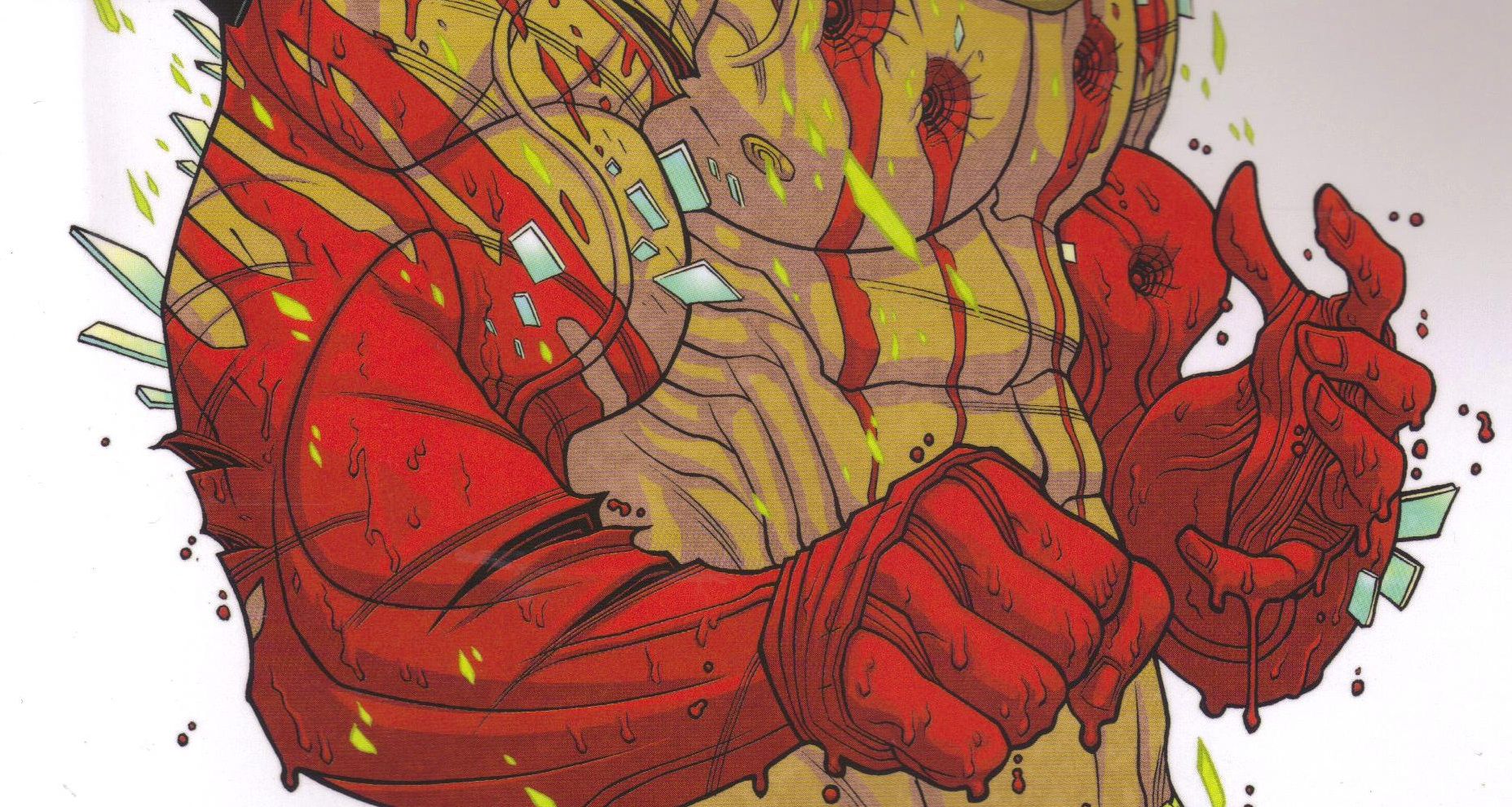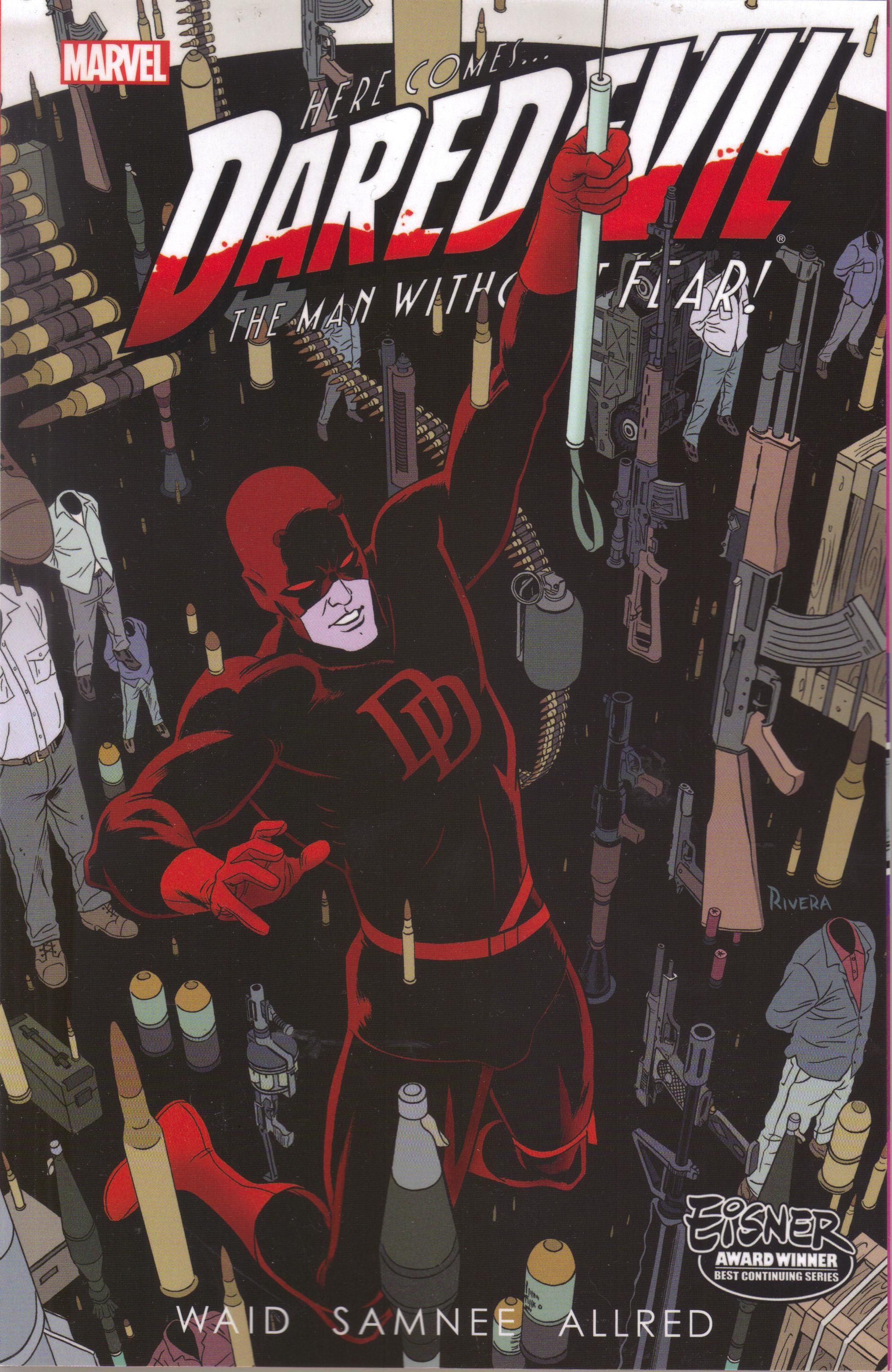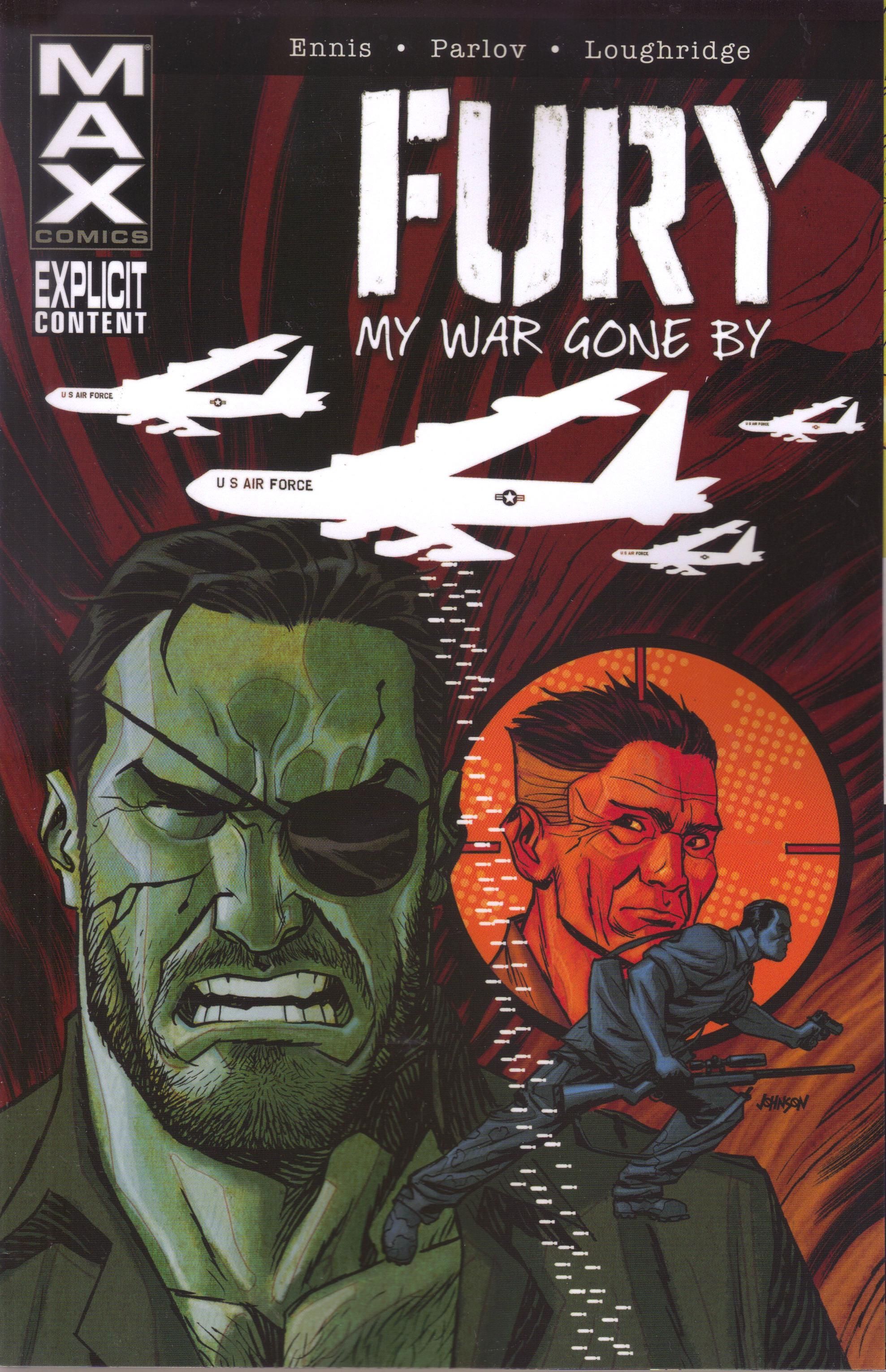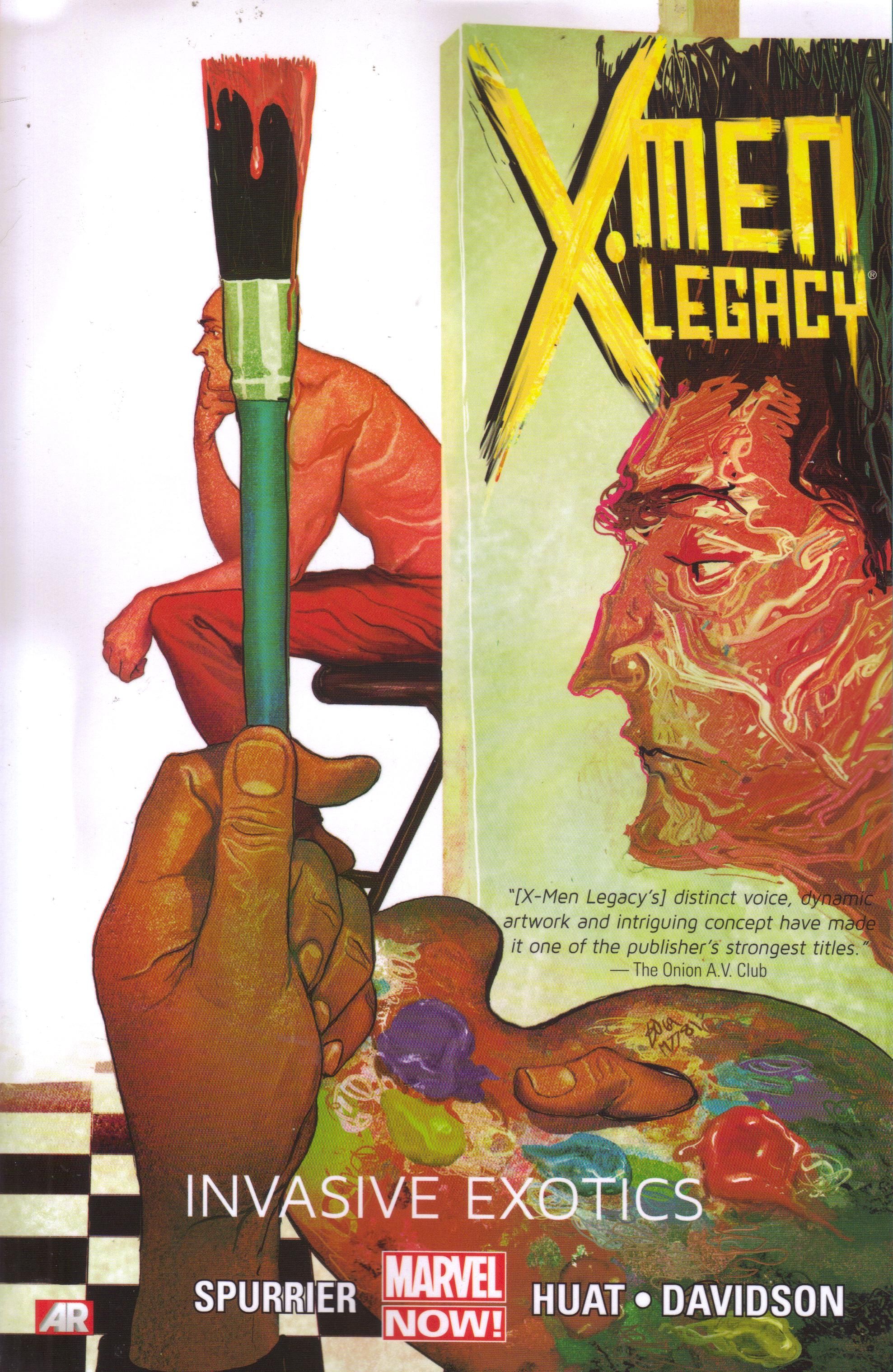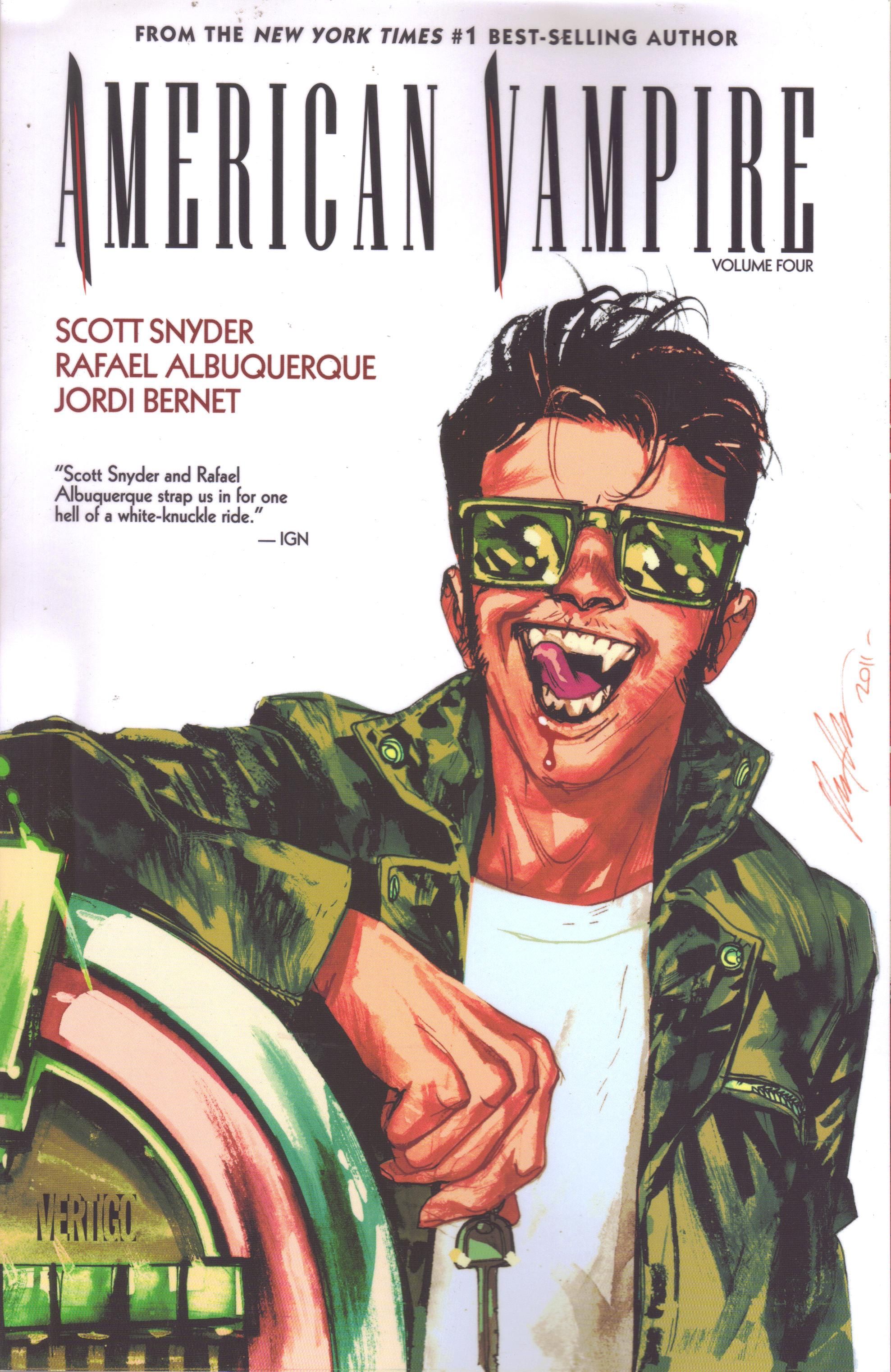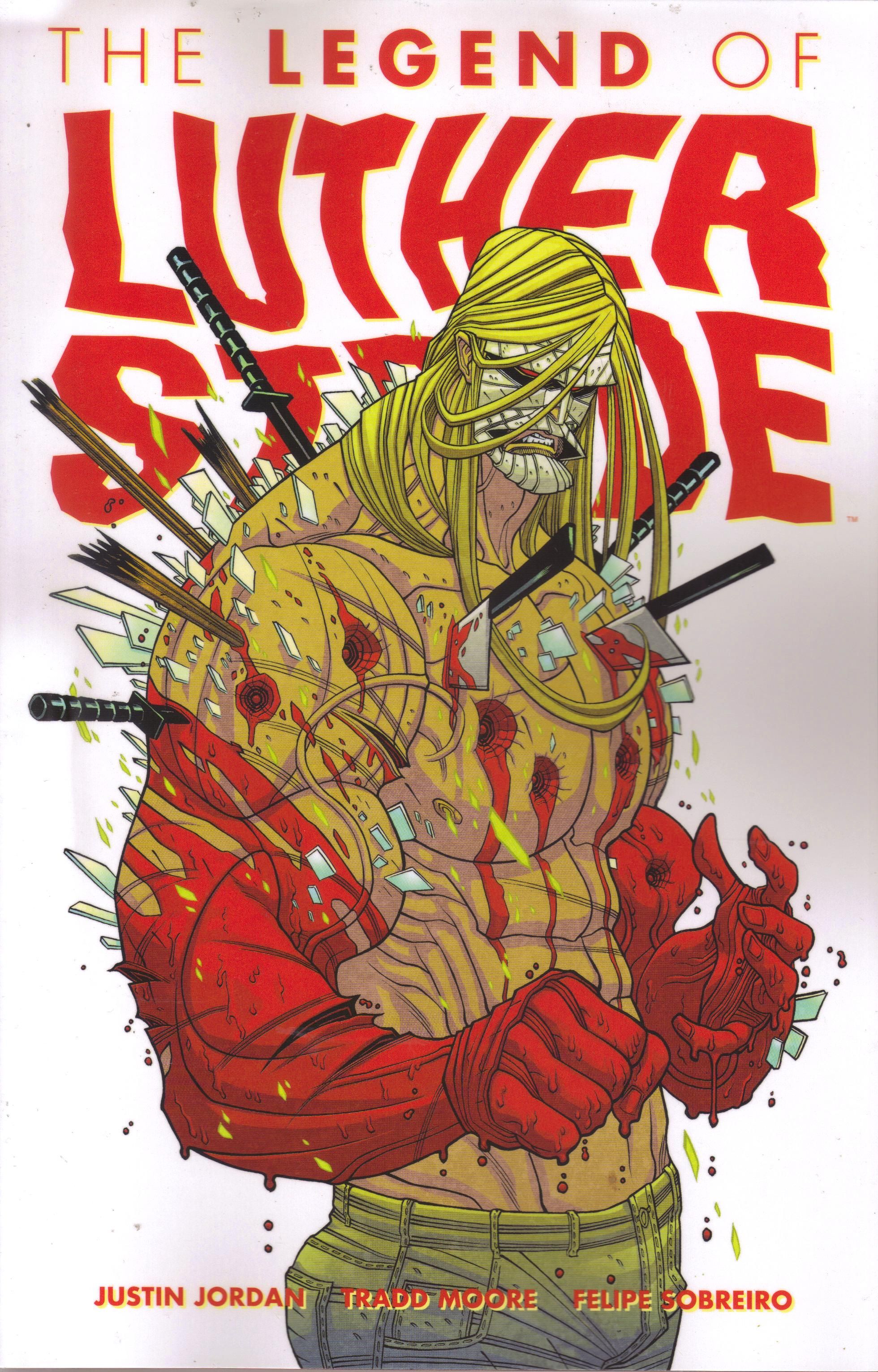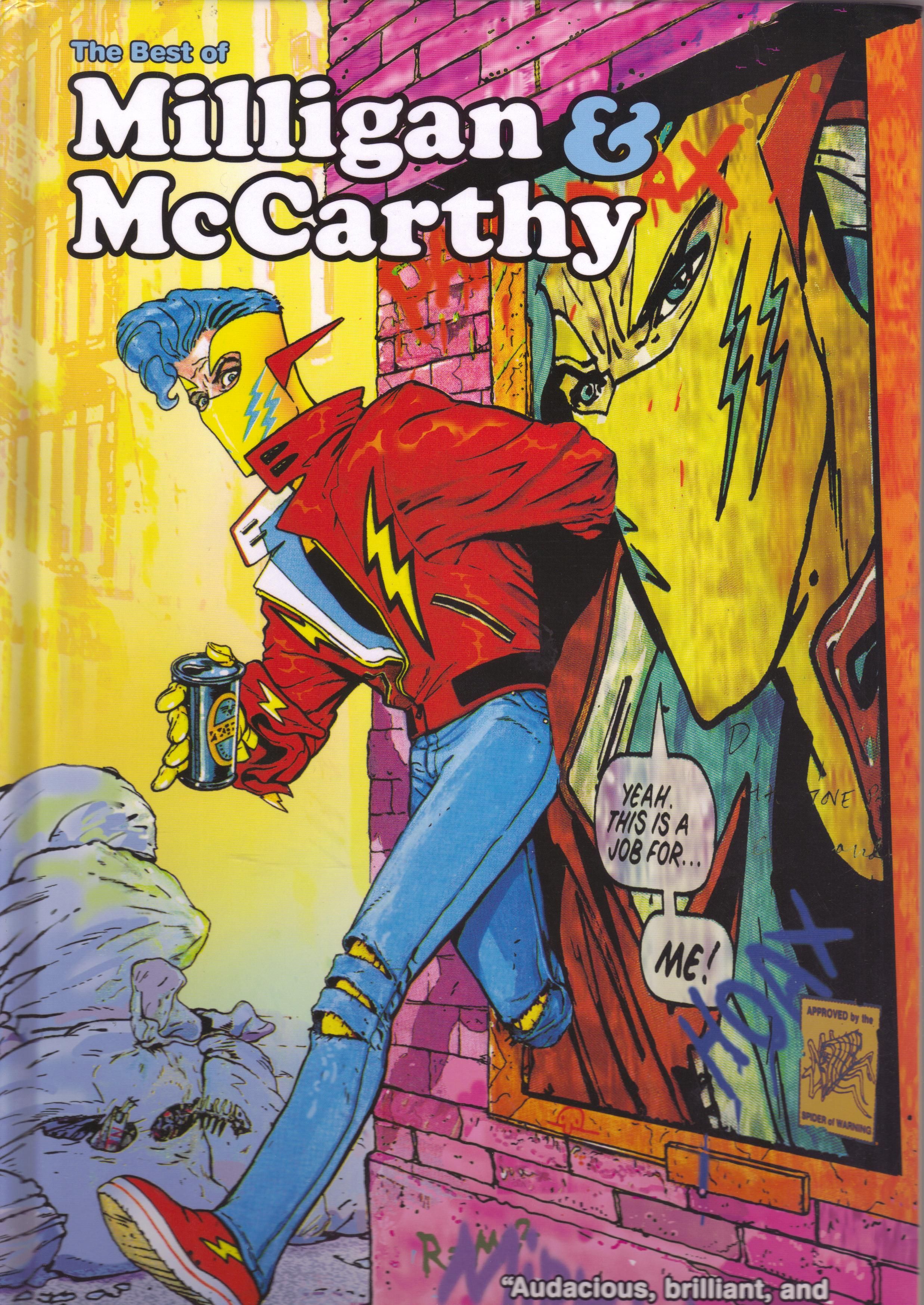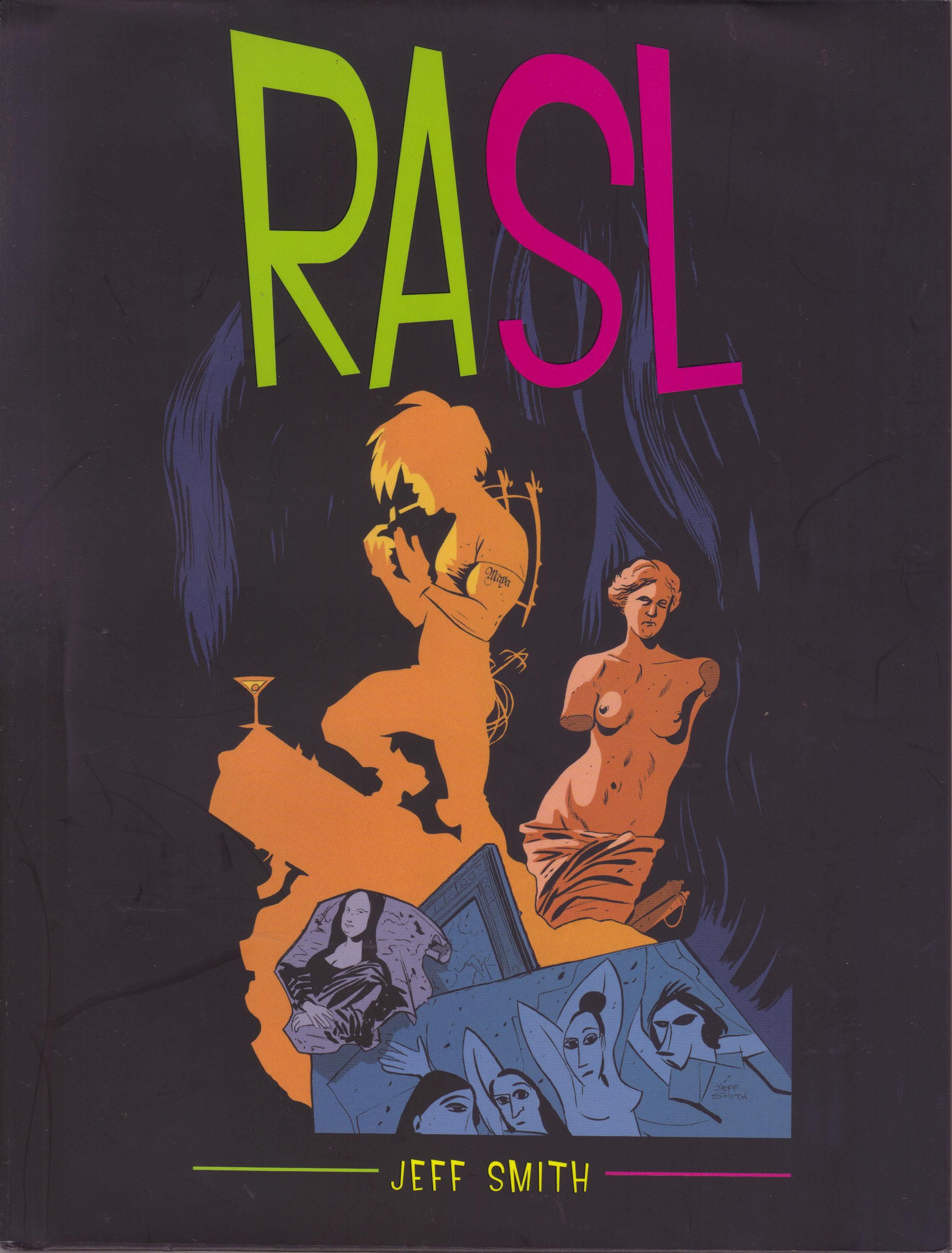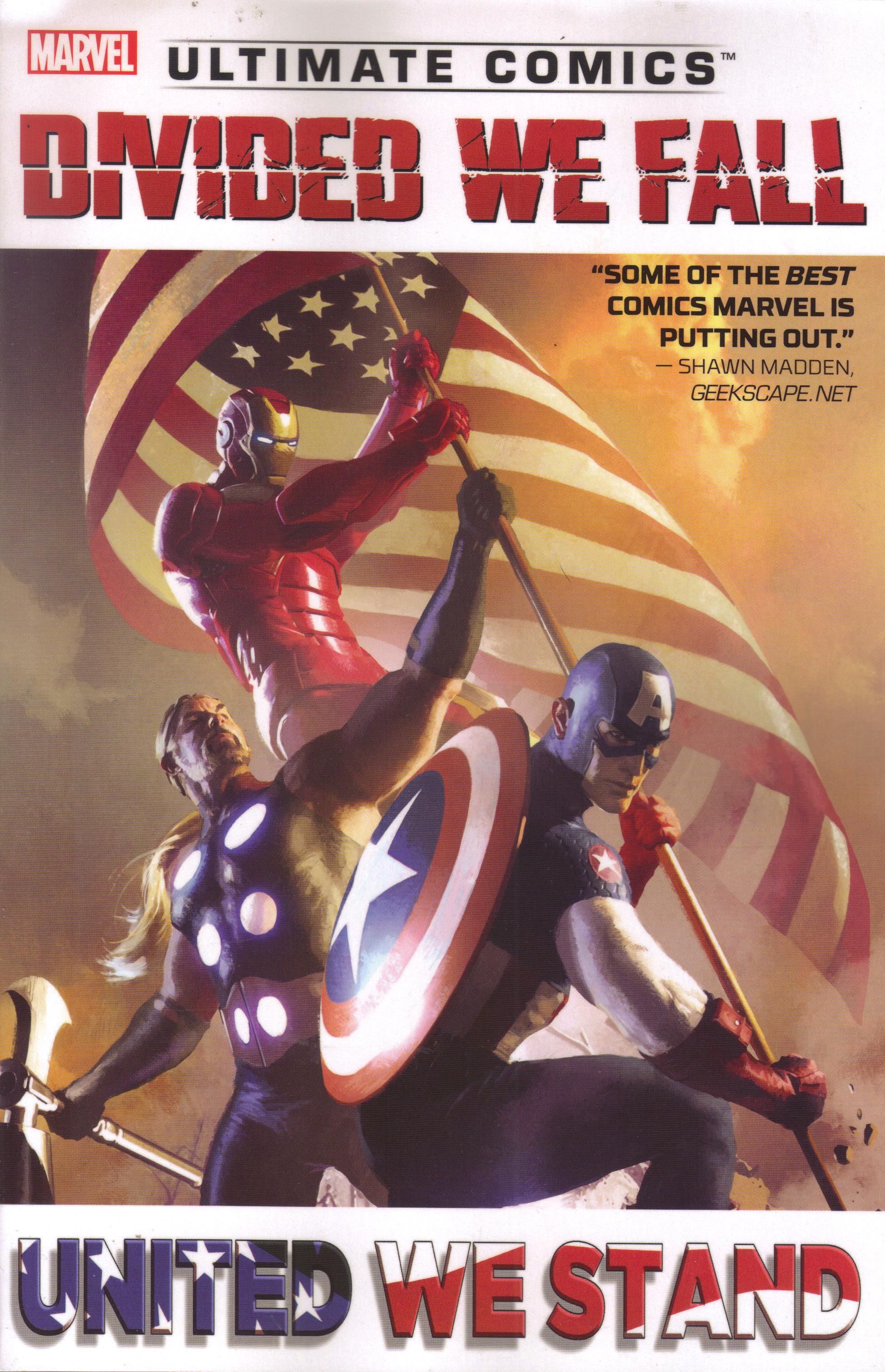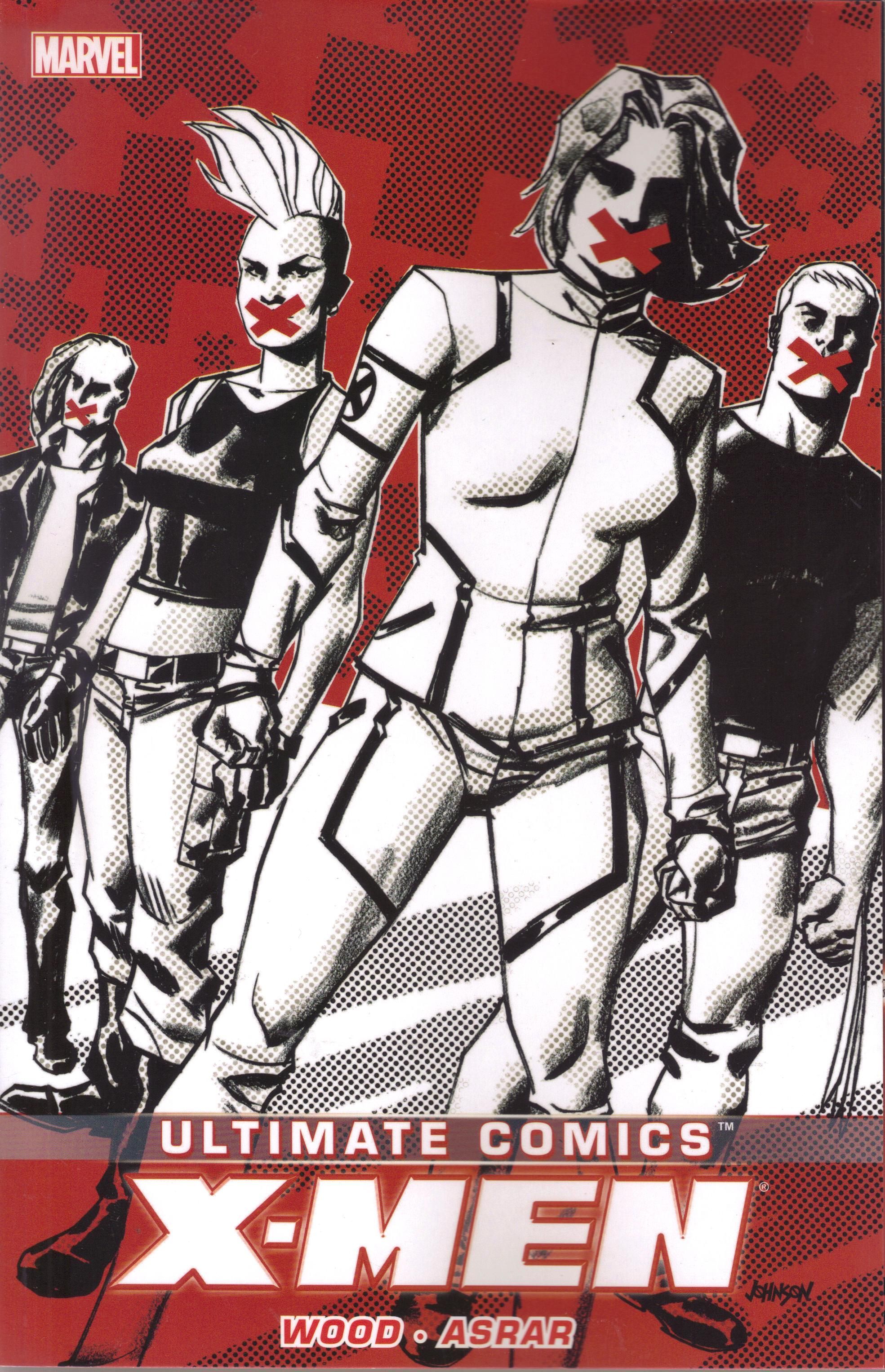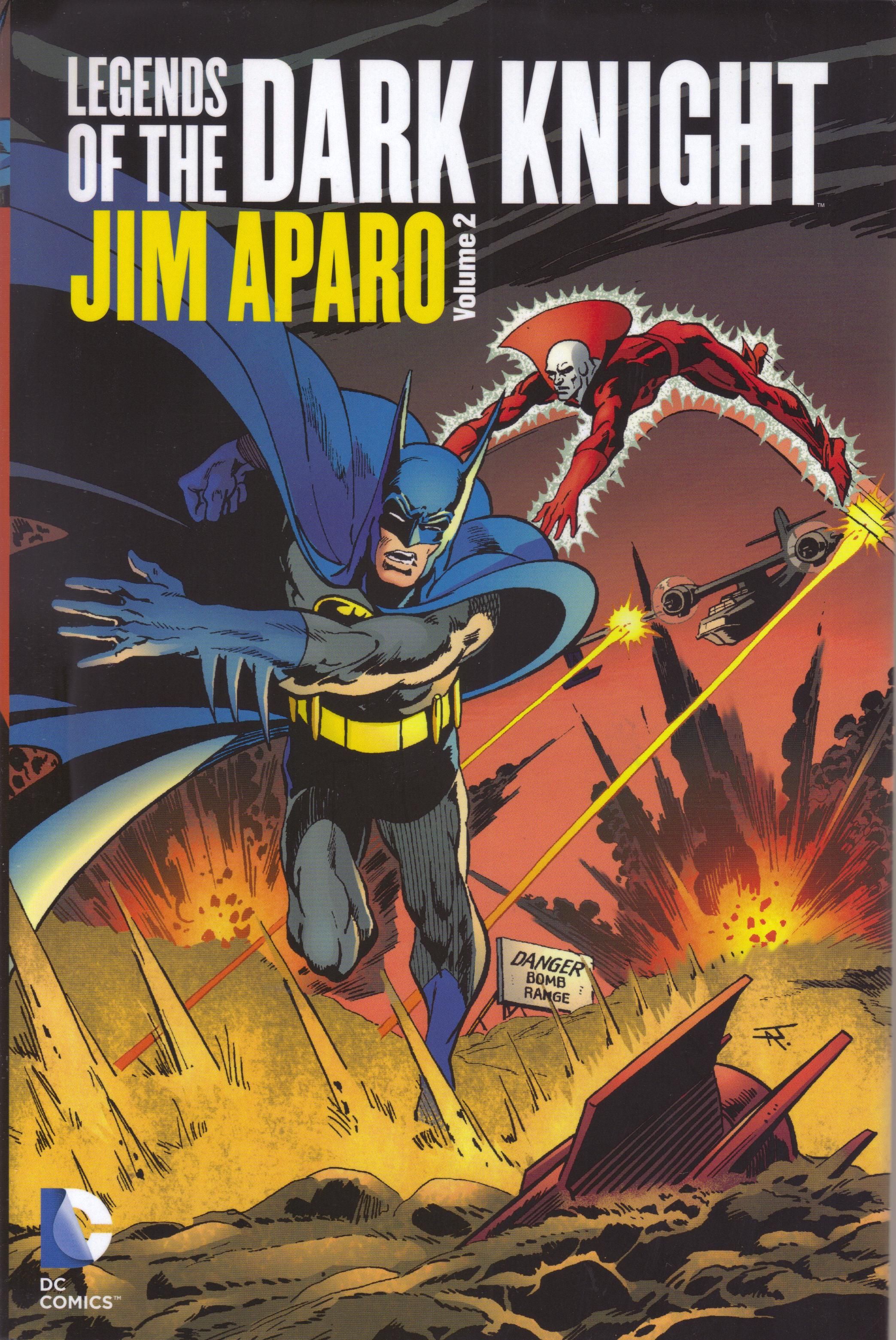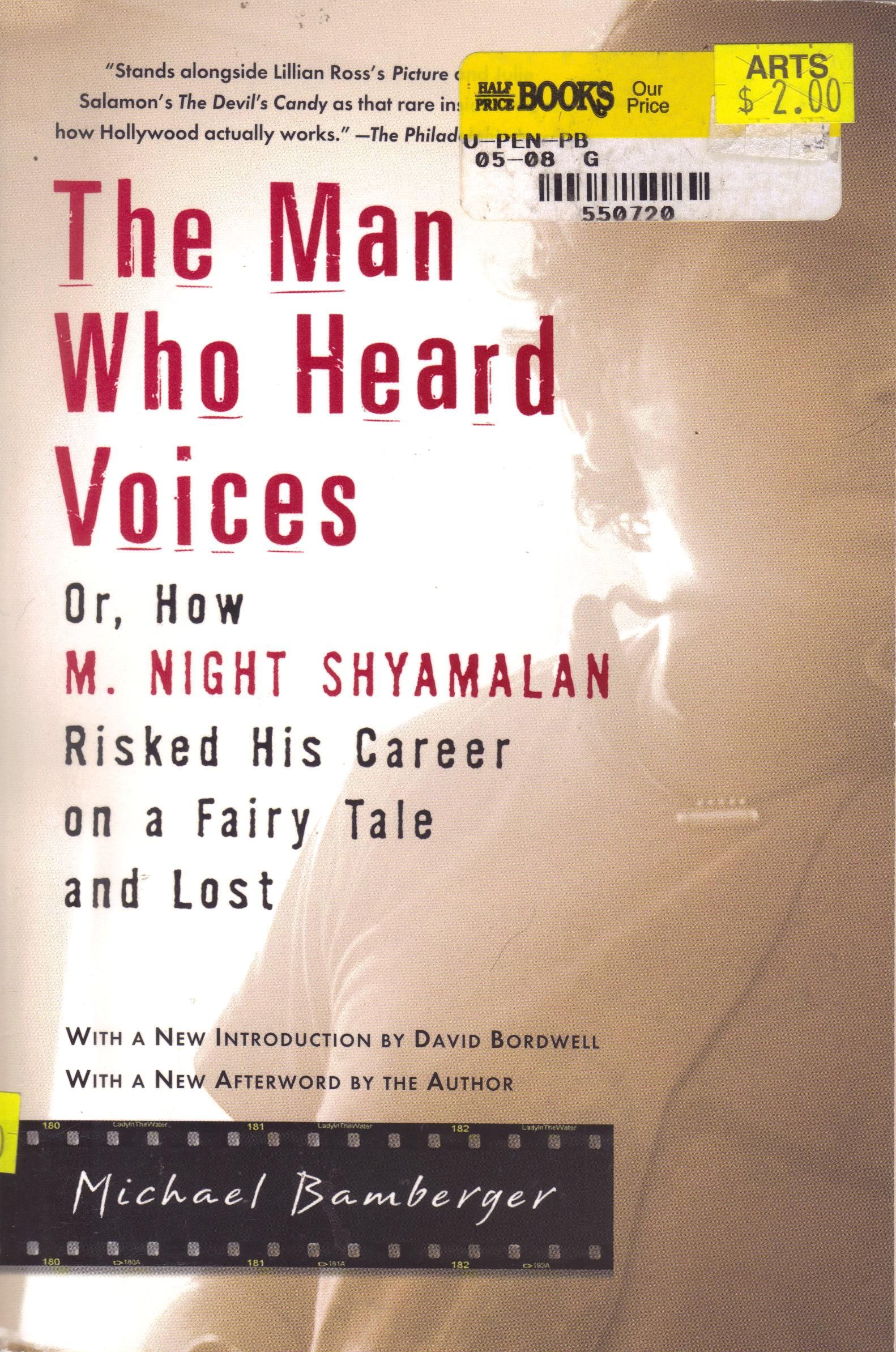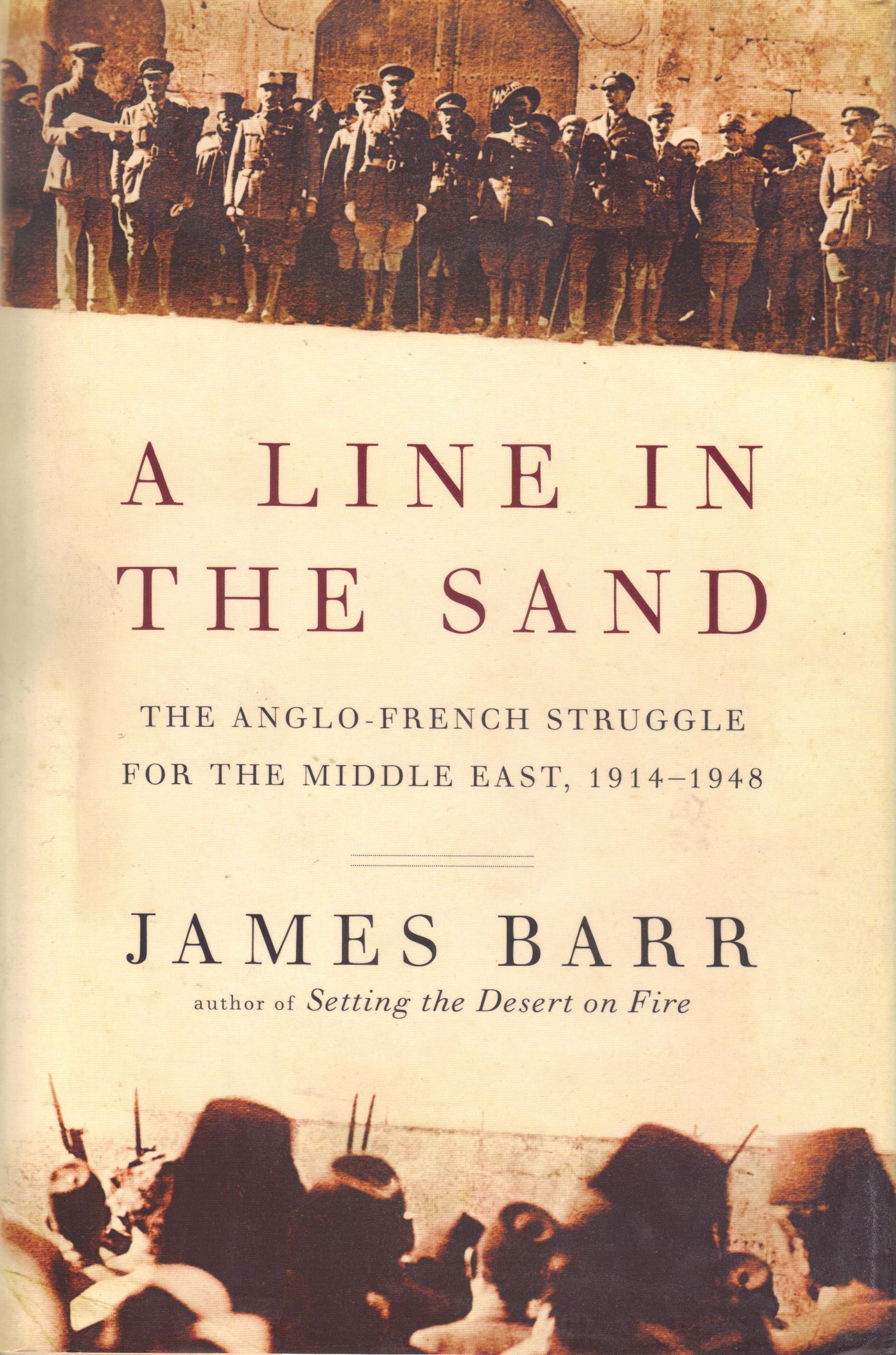"A fool tried to sweat me, actin' like he was hard / I stuck him twice in the neck and left him dead in the yard"
Daredevil volume 4 by Mark Waid (writer), Chris Samnee (artist), Michael Allred (artist), Javier Rodriguez (colorist), Laura Allred (colorist), Joe Caramagna (letterer), Alex Starbuck (assistant editor), Nelson Ribeiro (assistant editor), and Cory Levine (editor). $16.99, 120 pgs, FC, Marvel. Daredevil and Foggy Nelson created by Stan Lee and Bill Everett. Milla Donovan created by Brian Michael Bendis and Alex Maleev. Iron Man created by Stan Lee, Larry Lieber, Don Heck, and Jack Kirby. Doctor Strange created by Stan Lee and Steve Ditko. Scott Lang created by David Michelinie and John Byrne. Stilt-Man created by Stan Lee and Wally Wood.
I am still buying Daredevil, even though the second and third volumes weren't as good as the first, but they weren't bad enough for me to drop the book. Readers reassured me that after Samnee came on board as the new artist, things got back to the goodness of the first several issues, and so I dutifully picked up volume 4. And things did improve. Whattayaknow?
Daredevil was screwed up at the end of volume 3, so Scott Lang, Tony Stark, and Stephen Strange have to muck around in his head. That done, he returns to his law office, where Foggy has uncovered the bones of Matt's father ... in Matt's desk. Yeah, ick. Matt tries to tell him that he had nothing to do with it, but Foggy is having none of it, and he basically fires Matt. That has to suck. After a fill-in issue (which is a flashback to the "1960s," so of course Mike Allred draws it), we get to the meat of the trade, as Foggy takes on a case of a young woman accused of murdering a mob boss, while Matt tries to figure out if he's gone insane - his wife, Milla, ends up in his bed, but when Foggy checks on her in the asylum, she's there; another mob boss gets killed in an inexplicable way almost right in front of Daredevil - and if not, figure out what's going on. Eventually, we get a pretty cool confrontation with a bad guy, but I certainly don't want to give too much away, and Foggy does something monumentally stupid. Foggy's decision leads right into the next arc, I assume, as this volume ends on a bit of a cliffhanger.
This is an enjoyable story, although Waid hangs a pretty big lampshade in the middle of it and never quite resolves it. It's ridiculous to think that Foggy wouldn't immediately think that a super-villain is doing something to Matt, even if Foggy is worried about Matt's state of mind. The fact that this is such a big part of their falling-out makes it even more ridiculous. There's certainly reason to be concerned about Matt's state of mind, but when you're in the Marvel Universe and this kind of crap happens a lot, that should be the default explanation until you can prove it's not a super-villain. So while Waid does a very cool job with the way the bad guy turns the screws on Matt, the entire story hinges on this annoying plot point.
Samnee is great, of course, as he's just an excellent superhero artist right now. He nails the few big reveals he has to nail, and he draws a very good angry Matt. The nicest thing about Samnee's art might be his subtlety - when he shows the faces of the women who are being used as drug mules, he really does a wonderful job with their despair at their lot, and the final two panels of the book, where Kirsten realizes she's done something dumb, is very cool. It's a wonderful book to look at (Allred, of course, is excellent, too), and it's nice that they got the art team stabilized a bit.
I'm still of the opinion, despite Brian's evidence, that Daredevil gets a lot of accolades because it's so much less awful than most comics coming out right now and that if it came out during a less awful time in comics history, this would be a decent-but-unspectacular book. It is, in fact, decent but unspectacular. It's enjoyable to read, and the fact that Waid seems to have been able to work through the weird crossover-itis that afflicted this book makes me confident for volume 5. But I'll have to wait a while for that, won't I?
Rating: ★ ★ ★ ★ ★ ★ ★ ☆ ☆ ☆
Fury: My War Gone By volume 2 by Garth Ennis (writer), Goran Parlov (artist), Lee Loughridge (colorist), Rob Steen (letterer), Alex Starbuck (assistant editor), Nelson Ribeiro (assistant editor), and Jennifer Grünwald (editor). $19.99, 140 pgs, FC, Marvel. Nick Fury created by Stan Lee and Jack Kirby. Frank Castle created by Gerry Conway, Ross Andru, and John Romita Sr.
Ennis and Parlov finish up their Fury series, and like the first volume, there's really not much to say. Ennis writes good war stories, Parlov is excellent on this book, and things play out pretty much like you expect them to, but because Ennis is such a good writer, he's able to invest the plot with an emotional resonance that would be missing in the hands of a lesser writer. As Fury's colleagues get older, we see the hole it creates in his life, because he doesn't age as fast as they do and he never had anything to go back to when the fighting was over. Hatherly has a big family and grandchildren, but Nick has nothing, not even Shirley DeFabio, his fuck buddy, who's married to the noxious Pug McCuskey, the unctuous politician whose star is tied to Fury's clandestine activities. I'd say this is a tragedy for Fury, but like so many stories in this vein, everyone else suffers more while the writer tries to convince us that the hero is really suffering. I mean, yes, Fury is all alone, but he's lived his life doing what he was born to do, while Shirley never got that chance. The best scene in the book is when Shirley visits Hatherly in the hospital (he's old, whatareyagonnado?) and they have a brief conversation. When Ennis decides to write about real life, he's tremendous. That's not to say he's not great at other stuff, too, but his best stuff pulses with true sentimentality, not mawkish crap, and that's what makes this comic a worthy read. Yes, there's a lot of violence and bloodshed and kicking ass, but the scenes when Ennis gets into the emotions of the characters are the brilliant ones, and there are several of those and we don't have to wade through any puerile shit to get to them. The bloody scenes in this book are powerful, not childish, and they help set up the final scene beautifully. Ennis can still write damned good comics when he wants to, and this is a nice addition to his bibliography.
Rating: ★ ★ ★ ★ ★ ★ ★ ★ ☆ ☆
X-Men Legacy volume 2: Invasive Exotics by Simon Spurrier (writer), Tan Eng Huat (penciler), Paul Davidson (artist), Craig Yeung (inker), Jay Leisten (finisher), José Villarrubia (colorist), Rachelle Rosenberg (colorist), Cris Peter (colorist), Cory Petit (letterer), Alex Starbuck (assistant editor), Nelson Ribeiro (assistant editor), and Mark D. Beazley (editor). $15.99, 120 pgs, FC, Marvel. David Haller created by Chris Claremont and Bill Sienkiewicz. Blindfold created by Joss Whedon and John Cassaday. Ruckus created by Peter David and Larry Stroman. Pixie created by Nunzio DeFilippis, Christina Weir, and Michael Ryan. Chamber created by Scott Lobdell and Chris Bachalo. Johann Schmidt created by Joe Simon, Jack Kirby, and France Herron.
The second volume of X-Men Legacy continues with David trying to be more proactive, which is fine, but it kind of hits a snag in the second half when David tries to figure out what's going on with yet another group claiming to have a cure for mutantcy. It's kind of fascinating seeing that Spurrier, who cut his teeth doing short stories, is much better at the single-issue stories than when he expands a bit, as the first three issues in this collection are far better than the second three, and it doesn't really have anything to do with the art switch (Davidson's style might not be for everyone, but I like it, and both he and Huat do fine work in this volume). The first issue (#7) is about a different anti-mutant group, and Spurrier and Huat make them just wacky enough so they're not too scary until they start to be more aggressive, and the shift is handled well. That story ends up tying into the final three issues a bit, but it can easily be read as a single-issue story. In issue #8, David helps a mutant whose power causes everyone around him to attribute every good thing that happens to him - so when a new Captain Ultra shows up to thwart a mugging (and who doesn't love Captain Ultra?), everyone thinks this mutant saved them. It's another story that pays off in the final arc, but it's also a nice story about how David can help mutants without becoming too big of an influence. Finally, in issue #9 he goes on a date with Blindfold (which is confusing, as they end up on the moon but appear to be in a city moments before, and she never notices that they move) that turns dark as David tells her a story about an evil dude who's planning on killing all the mutants. It's a standard anti-mutant story we've heard before, but Spurrier tells it cleverly and doesn't let David off the hook at the end.
Then we get the three-part story about the anti-mutant group, and while it's not bad, it's also a bit more standard than I'd like. The fact that Spurrier knows how clichéd this all is and comments on it doesn't help (and yes, it's another example in this post of a writer hanging a lampshade; I'd rather they come up with something different rather than comment on how un-different their stories are), but he tries his best to put an interesting spin on the scenario and sort-of succeeds. At least he keeps the arc short - if this were almost any other writer this would be a six-issue arc, but Spurrier doesn't have time for that!
Huat continues to do great work on the book - his weird religious zealots and his Captain Ultra are superb - and Davidson is a good artist for the slightly harder-edged anti-mutant arc. It's unfortunate, as always, that Marvel wants to cram as many issues of any particular book into as little time as they can, as no artist can keep up with the schedule and even Davidson can't do the entire three issues - Leisten's finishes on issue #12 mean that Davidson's crisp pencils are softer and less decisive. I just can't understand Marvel's policy, because it really does hurt the product. I guess as long as we suckers keep buying them, they don't care.
This is still a pretty cool series. I'm curious to see where Spurrier is going with it.
Rating: ★ ★ ★ ★ ★ ★ ★ ½ ☆ ☆
American Vampire volume 4 by Scott Snyder (writer), Rafael Albuquerque (artist), Jordi Bernet (artist), Roger Cruz (artist), Riccardo Burchielli (artist), Dave McCaig (colorist), Jared K. Fletcher (letterer), Pat Brosseau (letterer), and Peter Hamboussi (editor). $16.99, 180 pgs, FC, DC/Vertigo.
After 27 issues of the regular series (which this fourth volume goes up to) and two separate mini-series, there's not much to say about these trades, is there? Snyder keeps doing what he's doing, and it's exciting and interesting and the stories are illustrated by great artists. The Bernet story is a Western, because apparently if you employ Jordi Bernet these days you have to get him to draw a Western (not that there's anything wrong with that; his sparse and sturdy pencil work is perfectly suited for it), and in it Snyder shows us that there were other American vampires before Skinner Sweet, expanding the mythology of his book just a bit more. Albuquerque is back for the middle arc, which introduces Travis Kidd, a 1950s greaser who happens to hunt vampires. He's after the one who killed his parents throughout this arc, but Snyder throws some nice twists into the whole thing, always keeping us on our toes. This arc might be one of the better ones for Albuquerque to draw in the series, because he has such a fluid style and so much of this arc features drag racing, so Albuquerque really kills on it. It's a phenomenally fast-paced arc, which works really well sandwiched in between slightly more sedate ones. "The Nocturnes," the two-issue arc that finishes this collection, focuses on Calvin Poole, who ends up in Alabama in the 1950s to see his brother (he can't show himself, but he steals glances) and gets involved with some oddball vampire species. It's a solid story, although Snyder tries a bit too hard to make it about not judging a book by its cover. Cruz, who's a good artist when he's not drawing X-Men comics in the 1990s, and Burchielli do solid if unspectacular work on the issues. If you're going to get guest artists, you could do a lot worse than the three gentlemen who pick up Albuquerque in this volume.
American Vampire continues to be Snyder's strongest comics work, mainly, perhaps, because he's not bound by anyone or anything and he can do what he wants. He can kill off a character in this book and not worry about that character being resurrected by editorial fiat (of course, it's a vampire book, so who knows about Snyder's plans). He can do a lot of different things that he just can't do in the mainstream DCnU. And while you'll notice that my thesis about him not doing well with endings is not really challenged in this book (because he always leads into another arc), he still does finish the individual stories fairly well. Sure, there's a problem with time in the Travis Kidd story. But other than that, this is another solid collection of this solid series. Bring on volume 5!
Rating: ★ ★ ★ ★ ★ ★ ★ ½ ☆ ☆
The Legend of Luther Strode by Justin Jordan (writer), Tradd Moore (artist), Felipe Sobreiro (colorist), and Fonografiks (letterer). $17.99, 139 pgs, FC, Image.
I enjoyed the first Luther Strode story, even though I thought Jordan was overselling its depth a bit - he wanted to write a story where lots of people get killed in imaginative ways, and by golly, that's what he did! Moore's art was enough for the price of admission, though, and the story was perfectly fine. Now the creative team is back for a sequel, and it's slightly better than the original series, if only because Jordan is able to get a bit more characterization into it. Fret not, though - it's still ridiculously violent!
Jordan jumps ahead five years, and Luther is now a loner fighting a bloody war on crime. The group of dudes who has power similar to his is still looking for him, though, and when they find him, things get very messy very quickly. Jordan has an opportunity to fill in the history of this group a bit, and the main villain turns out to be Jack the Ripper, because why not? He also brings back Petra, Luther's crush from the first series, who seems to want to kill him but really just wants to find him to help him deal with his issues. Jordan moves their romance along well, and it's nice that Jordan shows how Luther changes throughout the book, as Petra helps him open up a little. Luther is a bit sullen at the beginning of the book (not surprisingly), and I appreciated that Jordan didn't keep him that way. He wants to live a normal life, and while he knows that's impossible, his relationship with Petra (as weird as it is, what with the people trying to kill them) gives him a semblance of it.
I worry that this series won't continue because Moore won't be around to draw it. He's simply superb, and Jordan couldn't have asked for a better collaborator. He's unbelievably detailed, so that you can almost feel every wound that every character suffers, but his dynamic, cartoony style is perfect for giving us wonderfully fluid fight scenes. His choreography is fantastic - you can see every move play out across the page, and it helps make these ridiculous battles more realistic. His sinewy Jack is excellent and terrifying, especially when he's matched up against the giant bulk of Luther. He and Sobreiro do some amazing work with Jack, painting effects in some panels to make the villain even more otherworldly. Obviously, Moore deserves to get work that pays him better, but I'm going to be selfish and hope he makes enough from this series to continue it, because it's obvious Jordan has at least one more big Luther Strode story in him.
Both Luther Strode series are good books, and as Jordan points out, you don't really need to read the first to read this one (it helps, but he gives us enough in this to fill in some blanks). If you're only in the mood for one trade, this is slightly better, and I hope we'll get another mini-series next year or so. That would be cool.
Rating: ★ ★ ★ ★ ★ ★ ★ ★ ☆ ☆
The Best of Milligan & McCarthy by, you know, Milligan and McCarthy. $24.99, 256 pgs, FC, Dark Horse.
Greg Hatcher often calls this the Golden Age of Reprints, and when Dark Horse publishes something like this, he's certainly not wrong. This book is chockers with old-skool Milligan and McCarthy wackiness, and it actually makes me angry that Milligan occasionally writes crap like Elektra or even boring stuff like his run on X-Men, because he's in full weirdness mode on these pages, and it's pretty glorious. We get some of the Milligan/McCarthy classics like Paradax!, Rogan Gosh, and Skin, and we also get stuff like The Electrick Hoax from 1978, Sooner or Later, their time-traveling strip, and Summer of Love, a surreal but charming love story. There's quite a bit of Freakwave, which came about because McCarthy visited Australia and became obsessed with surfing and The Road Warrior, and there's even a creepy story called The Hollow Circus, about a hunchback with a bit of a persecution complex. It's all quite brilliant.
The two long-form comics in this are Rogan Gosh and Skin. Rogan Gosh is a surreal trip through several layers of reality that turns out to be a love story, while Skin is the infamous tale of a thalidomide skinhead in the 1970s who really doesn't like anything or anyone. Rogan Gosh is more ambitious and better than Skin, because Milligan and McCarthy are trying so many different things and the characters are far more interesting. Martin, the skinhead, is fairly dull, and the story is far too similar to the overrated A Clockwork Orange, so while McCarthy's art is excellent and Carol Swain's coloring is brilliant (Skin looks so different from the rest of the book, mainly because McCarthy and Swain wanted to "reflect the ugly tone of the script," according to a text piece in this collection), the story is nothing special. The rest of the book features the creators' wonderful characters, beginning with Paradax, a superhero who's more interested in being rich and famous (he's one of the earliest of these kinds of characters) and going on from there. Milligan's scripts are often wickedly funny, thrilling, political, and bizarre, while McCarthy's gorgeous and detailed pencil/paint work runs the gamut from "simple" cartooning (nothing in the book is really simple) to bold uses of multimedia and exquisite layouts. It's impressive to see The Electrick Hoax - all six pages of it - because you get to see McCarthy's pure pencils, before he moved past it, and you can tell how well he incorporated those skills into bolder painting and even the clever use of clip art. The Electrick Hoax would not look out of place in Mad magazine, and although McCarthy's sense of humor got weirder over the years, he never lost it, which is partly why his art is such a delight.
It's too bad Milligan doesn't go too nuts anymore with this kind of writing. He's still excellent, but this stuff is so raw and weird, and it's thrilling to sit down and page through this book. It's a tremendous collection, and I love that we schlubs who didn't live in England in the 1980s (I know, I'm such a loser) can now read all of this stuff.
Rating: ★ ★ ★ ★ ★ ★ ★ ★ ★ ☆
Rasl by Jeff Smith (writer/artist), Steve Hamaker (colorist), and Tom Gaadt (additional color and design). $39.95, 468 pgs, FC, Cartoon Books.
So, yeah, I'm going to have to talk about some SPOILERS here. Sorry.
...
...
...
Jeff Smith's Rasl is a very nice package - it's 40 bucks for the entire, 15-issue epic, and it's been colored, which doesn't really mean too much (I own Bone in black and white, and it's brilliant), but it's still nice. As a good deal of the book takes place in the desert around Tucson, the contrast between the reds, browns, yellows, and oranges of the desert with the bright blue of the sky is nice, while the desert color palette extends to the interiors of buildings and the people. As someone who lives in the Sonoran Desert, I enjoyed the tone of the coloring, because there is a kind of dirt-ness that exists all over the landscape while the blue of the sky is crisp and piercing. So the coloring is very good.
Smith's art is always good, and even with Rasl's overly-large head (seriously, what's up with that?), the book looks great. He makes the mysterious dude chasing Rasl creepy, and the weird girl who follows our hero around is both creepy and tragic. The two main female characters are attractive without being "comic book hot" - they look like actual women. Smith has always been good at action scenes, and there are several good ones in the book, and he uses photo references of historical events well - he actually draws them, so they don't look too out of place, but because he's modeling them on photographs, they look like the people he's referencing. Visually, the book is well done - Rasl is appropriately bloody most of the time, because he takes a lot of punishment, and it always appears that he really feels all the pain his body is absorbing. Smith draws the special effects, too, so they look fully integrated into the visual narrative.
Smith's story is perfectly fine - his main character is mysterious at the beginning, stealing famous works of art and jumping across parallel universes, but Smith paces it well so that we slowly discover that he's a scientist on the run from a shadowy government agency who wants to use his research for military purposes. Smith ties this all into comic writers' favorite scientist, Nikola Tesla (Rob Schmidt pointed out to me that there are others like me who think that writers should stop using Tesla all the time), and his research, and he throws in a love story (actually, two) while he's at it. Despite the multitude of pull quotes on the back, there's nothing extremely original about the story - if a comic book reader in this day and age hasn't read a book where Tesla is the High Priest of Awesome, I worry about that comic book reader - but Smith tells it well, with some nice twists and interesting characters. If you're going to write a story in which technology has the potential to destroy the world - a plot which has been done once or twice - it's best to have interesting characters. For the most part, Smith does.
But (and here are the SPOILER parts) Smith drops the ball in a couple of places that keeps this from being a truly great book. First, there's a pretty clear example of Women in Refrigerators in this book, and I'm surprised more wasn't made about it when the book was being serialized. Now, you could claim that because there are parallel universes and an iteration of the character is still alive in another dimension, it doesn't count, but the whole thing feels lazy, because Smith doesn't really do anything with the character even after Rasl discovers another version of her. For a nominally main character, she's remarkably underdeveloped and dropped pretty early on. In some serial fiction, characters are dropped because the writer finds him- or herself going in a different direction as the story unfolds. This feels like Smith plotted it out quite well before he began, so the fact that the character is not only killed simply to get a reaction out of the male main character and then the alternate version disappears is weird.
Second, Smith uses Pop Culture Rule #1, and when that happened, I almost yelled at the pages. It seems early on that it's fairly obvious that he's leading us to one of the revelations Rasl has about the character, but then, when the Rule rears its ugly head, it weakens the overall narrative. The way Smith establishes the character makes the twist come out of left field, and when said character explains a bit, the fact that Smith didn't explore the rather more unconventional thoughts the character had is more disappointing. The twist at the end really makes the story less interesting, because it retroactively ruins quite a bit of what worked in the story - namely, the romance part. For a comic by a creator who can certainly do a lot better, the laziness of the final twist is very disappointing.
It's these things that keep me from loving Rasl as much as I want to, even though it's not a terrible comic. There's a lot to like in the book, and it's always nice to see Smith doing his thing. The book is lovely to look at, and individual parts of it are very good. The whole, however, falls a bit short. Too bad!
Rating: ★ ★ ★ ★ ★ ★ ☆ ☆ ☆ ☆
Ultimate Comics: Divided We Fall, United We Stand by Sam Humphries (writer), Brian Wood (writer), Brian Michael Bendis (writer), Billy Tan (penciler), Luke Ross (artist), Timothy Green II (penciler), Paco Medina (penciler), Reilly Brown (penciler), Carlo Barberi (penciler), Agustin Padilla (penciler), David Marquez (artist), Pepe Larraz (artist), Terry Pallot (inker), Juan Vlasco (inker), Matt Milla (colorist), Ifansyah Noor (colorist), Andres Mossa (colorist), Jesus Aburtov (colorist), Marte Garcia (colorist), Justin Ponsor (colorist), Clayton Cowles (letterer), Joe Sabino (letterer), Cory Petit (letterer), Alex Starbuck (assistant editor), Nelson Ribeiro (assistant editor), and Jennifer Grünwald (editor). $34.99, 361 pgs, FC, Marvel. The Ultimate Universe created by Brian Michael Bendis, Mark Millar, Mark Bagley, and Bryan Hitch, basically.
I'm not quite sure why Marvel packaged all of these series together in this trade - the books take place at the same time (as evidenced by Captain American becoming president in all of them), but they don't tell one giant story. Instead, what we get are three separate stories all dealing with specific time frame, which is the aftermath of a big attack on Washington that killed almost everyone in the government and the fracturing of the United States. So yes, they're related in that Spider-Man fights with the Ultimates in their comic and then we see a bit more of what happens from his perspective in his own comic, but it's not like we can't figure out what's going on. Still, it's 18 issues for 35 bucks, which isn't bad.
The three stories themselves are just okay. I mean, it's the Ultimate Universe, so we can have something like the country fracturing and the Southwest splintering off and forming an anti-mutant territory and Texas declaring its independence and Washington blowing up, but ultimately, a lot of this is just good guys punching bad guys. The Ultimates story is the worst of this - it's a fine superhero punch-'em-up, but for how important the stakes are supposed to be, it feels kind of small - it ends up being a Hydra invasion run by an Asgardian who can manipulate people, and it just kind of sits there. Wood's X-Men story is better. It's about Kitty Pryde leading a small group of mutants to the Southwest to take on Nimrod and the anti-mutant groups there, which isn't the greatest plot, but because Wood is setting up his long-term idea of a mutant homeland, it feels like it's more important than the Ultimates story. The Spider-Man story is about Miles meeting Captain America, who wants him to quit superheroing. Eventually Miles proves himself to Cap, and there's a subplot about Miles's dad getting carted away by the government and getting rescued by Hydra, which goes kind of sour. Oh, and Miles is wanted by the cops because they think he killed his uncle, but he gets some good news regarding that in this trade. It's a typical Spider-Man story, and Bendis has been writing typical Spider-Man stories for 13 years now, so he's pretty good at them. Weirdly enough, some editor at Marvel dropped the ball, because the Hydra invasion is in Wyoming but a good deal of Spider-Man's part in it takes place in Wisconsin. All those states that begin with "W" aren't the same place, you East Coast Elitists!!!!
Art-wise, this trade is a mess. You'll notice the number of artists up there - 9 pencilers, 2 inkers (plus the pencilers who ink themselves), and 6 colorists to draw 18 issues. It's ridiculous. None of the artists do a brilliant job, even though they're all decent pencilers - Marquez gets better every time I see his art, and his work on Ultimate Spider-Man is probably the best in the book, and Brown is always good - and the colorists don't help, as a lot of the book is dark when it's not lit up by computer effects. Every time I see work like this, I'm more convinced that it's really hard to color a book digitally for glossy paper and make it look great, which is why we need to appreciate the really good colorists all the more. If we compare this to the book right below, which has one very good penciler and one of the best colorists working right now, the difference is striking. There's nothing really wrong with the art in this trade, it just doesn't elevate the pedestrian writing.
The best thing about this trade is that it's entertaining. It's fairly forgettable, and I read the next story arc in Wood's X-Men without having read this and I followed along just fine, so I'm not even sure how crucial it is. It's a fun read, but no one takes any chances. Perhaps that's why Marvel appears to be killing off the Ultimate Universe soon. When the regular universe is much more interesting than this one, what's the point of this one?
Rating: ★ ★ ★ ★ ★ ½ ☆ ☆ ☆ ☆
Ultimate Comics X-Men by Brian Wood volume 2 by Brian Wood (writer - imagine that!), Mahmud Asrar (penciler), Juan Vlasco (inker), Jordie Bellaire (colorist), Joe Sabino (letterer), Alex Starbuck (assistant editor), and Nelson Ribeiro (editor). $15.99, 100 pgs, FC, Marvel.
Meanwhile, a few weeks before Marvel released the first arc of Wood's Ultimate X-Men, they released the third arc in a trade, because they don't know what they're doing. Well done, Marvel!
See, this makes the case that you really ought to have a stable creative team. Wood's first story after he got Kitty and her group to Utah was pretty good, but it was a bit weak in the art department. For this trade, Wood is joined by Asrar and Bellaire, and it's a huge improvement. Back when I first saw Asrar on Dynamo 5, I knew he'd be snapped up by the Big Two as quickly as they found out about him, because he's such a good superhero artist, and Bellaire is phenomenal. They make the comic look excellent, which helps make Wood's script more impressive. Asrar draws great action scenes, so when Psylocke throws down with Karen, it's beautifully fluid, and when the soldiers attack Utopia, he makes it both large-scale and intimate, so we never lose sight of the stakes. Early on, his body language on Kitty makes her seem more unsure of herself, as she's still not quite convinced she can mold the community, and then, later, he draws her as much more assertive, and the change is palpable but still subtle. His facial expressions on Rogue as she wanders through the forest are wonderful, showing how Rogue slowly becomes more at home in Utopia, allowing her to change the course of the battle when she needs to.
Wood's story is good, too. I kept hoping he would go the way he did, and the fact that he did made me happy, because Wood has always been far more interested in the way characters act than how they work within a plot. He has a good plot - the government wants to take the land back (the parallels between this and the way the government treats Indians sitting on "worthless" land that is suddenly valuable due to, say, uranium deposits is a mere coincidence, I'm sure) and sends the army in, while Karen Grant wants to take it down because she's jealous, and Nomi is plotting against Kitty in the jungle because she's in a snit. So all these groups are coming together while Kitty keeps preaching about working for the good of the community and how they don't want to fight because it will give the army the excuse they need. I kept waiting for Wood to punk out, but he didn't, and he resolves everything in a very satisfying way while still leaving the door open for more shenanigans. This is why the Ultimate Universe exists - it really shouldn't look anything like the "real" world (which the Marvel Universe does resemble, because Marvel can't change it too much), and Wood takes things in a logical way. Nice to see.
You really don't need to read the previous trade to get this, but it's not a bad idea, because Wood is doing some good stuff with this. It certainly helps that it looks so great!
Rating: ★ ★ ★ ★ ★ ★ ★ ★ ☆ ☆
Legends of the Dark Knight: Jim Aparo volume 2 by Jim Aparo (artist) and Bob Haney (writer), with additional stories by Cary Burkett and Archie Goodwin, and some coloring by Jerry Serpe. $49.99, 525 pgs, FC, DC. Batman created only by Bob Kane and certainly not anyone else.
There's not a lot to say about this collection - either you're on board with 1970s Bat-craziness or you're not. I mean, it's Bob Haney (mostly) doing his insane writing, even though it's not quite as insane as the first volume, and it's Aparo doing his thing. The artwork is a bit rougher than the first volume, and I don't know if that's because Aparo was more rushed or if Serpe's coloring (he colors quite a bit of this) are deliberately messy, but it's still 1970s Aparo, which is by far the best Aparo. This collection has the famous Brave and the Bold issue in which terrorists hunt down Jim Aparo and Bob Haney even as Batman and Sgt. Rock try to stop them, and it's as bizarre as it sounds. There's also Green Arrow acting like a douchebag (even for him), there's Green Lantern defecting behind the Iron Curtain, and there's Catwoman in her hideous 1970s costume. Batman tells some guy, "Listen, fly boy - we paid you plenty to drop us down that volcano's stack ... so steer this bus closer!" Commissioner Gordon is targeted by an alien bounty hunter, because why not? The Joker figures out how to blow people up by making them drink wine. Aquaman stops Batman from finding a ship's log because he thinks it will prove that his dad was a lousy lighthouse keeper. Batman and Green Arrow go back in time to fight in the Battle of Agincourt. Bruce Wayne, dressed in a white leisure suit and black open-throat shirt (not unlike John Travolta), dances to "Staying Alive." Bruce Wayne dances to "Staying Alive," people. And, of course, this collection contains the infamous "buttlegger" issue. It's not a typo!
Okay, maybe these issues are as insane as the first volume. Either way, it's another brilliant slab of comics. It's chock full of Batman and his guest stars being awesome. Remember when DC superheroes were actually awesome? Pick this sucker up. You won't regret it!
Rating: ★ ★ ★ ★ ★ ★ ★ ★ ½ ☆
The Man Who Heard Voices by Michael Bamberger. 283 pgs, 2006, Gotham Books (a division of Penguin Group Inc.).
Michael Bamberger met M. Night Shyamalan in April 2004 and made a big impression on the director, so much so that Shyamalan asked him to write about the production of his next movie. That movie was Lady in the Water, and with hindsight, we can see that it was the movie that began Shyamalan's slow descent to hack, helming Will Smith's vanity project After Earth this past summer. Even when this book was published, it was clear that the winds of change were blowing around Shyamalan, and it would have been interesting if Bamberger had written an afterword after Shyamalan's The Happening, his next movie and the one that really toppled his career (Bamberger notes in the afterword that he doesn't like this book's subtitle, "Or, How M. Night Shyamalan Risked His Career on a Fairy Tale and Lost," especially the final two words). I don't remember Lady in the Water too much, but from what I do recall, it was a weird, quirky story that was better than Signs and far better than The Happening, but still problematic. I'm not sure it ruined his career, though - it seems The Happening did that (plus, Shyamalan's predilection for blaming stupid American audiences for rejecting his movies). That's neither here nor there, though - Bamberger had unlimited access to the making of a movie and the mind of a famous director, and he wrote a book. What's it all about?
It's a good book, although Bamberger is a bit too deferential to Shyamalan. It's not that he papers over the director's flaws, it's that he twists them so that Shyamalan comes off looking better. He's not stubborn and willful, he's independent. He's not obscure, he's artistic. Shyamalan has very good qualities - he's fiercely loyal, he makes a strong effort to get to know everyone on the set, not just the top actors, and he stays true to his vision - but they're tempered by his not being able to take criticism, even from the people he supposedly trusts, and a strange lack of knowledge about how the movie business works, even though he manipulates the system very well. Bamberger writes about how Shyamalan was able to get out of a contract with Harvey Weinstein so he could make The Sixth Sense without interference, and he managed to outfox the old Hollywood hand and get in bed with Disney. But when he delivered the script for Lady in the Water, which, he should have known, sounded about as non-commercial as you could get (and Shyamalan didn't want a movie star to play the lead), his Disney connections balked - not too much, as they still wanted to make the movie, but just enough so Shyamalan, who sounds like an extremely passive-aggressive, insecure person in many ways, decided to go to a different studio that would let him make the movie his way. I mean, he was writing a mythological story about a girl who wants humanity to save itself and he wanted Paul Giamatti to star in it, and he wanted $50 million to do it (the budget topped out at about $75 million). He didn't think this was a problem, apparently. Bamberger actually does a good job showing how he could fall deep into despair and blame himself for the movie's struggles during filming but then suddenly turn and blame someone else just as easily. Shyamalan comes across, simply, as a stereotypical artiste. It's still a fascinating portrait.
Of course, this is also a book about a movie being made, and Bamberger does a good job with that - how Shyamalan made the casting choices, how he trusted Giamatti implicitly, how he tried to get Bryce Dallas Howard to be less of an "actress" because she was just on the cusp of stardom and wasn't sure how to handle it, how the crew dealt with some of the odd technical challenges that Shyamalan threw at them. Shyamalan is a perfectionist, and he liked to do things "old-school" (which meant, among other things, editing without a computer), and those qualities meant that they shot far more film than necessary, and editing was a nightmare. But it all ties back into Shyamalan's personality.
Bamberger doesn't get into the strange casting choice of turning Bob Balaban into, essentially, Roger Ebert and then killing him, and he doesn't get enough into the even stranger casting choice of Shyamalan himself as the writer who will save the world. These are things Shyamalan knew critics (and audiences) would have trouble with (or at least he should have known), and Bamberger, while doing a decent job with Shyamalan's inner conflicts over whether he's any good, doesn't really get into the inner megalomania that comes from casting yourself as a savior. These two sides of the director are a good psychological reason for why he has struggled in recent years, but Bamberger skims over them a bit too much.
The Man Who Heard Voices is a quick and entertaining read, and while it's not quite as deep as it could be, Bamberger does have very good access and it doesn't appear that Shyamalan censored him before the book could be published or even himself while Bamberger was around, so we get a good portrait of the director, even if it could have been better. If you're a fan of Shyamalan's movies (and while I haven't seen his last two, I did like The Sixth Sense and The Village, and I loved Unbreakable), this is a cool book, and if you're interested in how a movie gets made, this is also pretty neat.
Rating: ★ ★ ★ ★ ★ ★ ½ ☆ ☆ ☆
A Line in the Sand: The Anglo-French Struggle for the Middle East, 1914-1948 by James Barr. 450 pgs, 2011, W. W. Norton & Company, Inc.
Barr's book is somewhat odd, even as it's a well-researched, in-depth, and pretty even-handed examination of the the title's premise. During World War I, two men - Mark Sykes and Francois Georges-Picot - got together a drew a line on a map of the Middle East, giving everything south of the line to Britain and everything north of the line to France. This kind of imperial arrogance is prevalent in the 19th and early 20th century, and it's led to all sorts of problems in Africa and Asia, including the mess we're currently facing in the Levant (given what's going on in Syria right now, the actions of the British and French imperialists a century ago remains incredibly relevant). Barr traces the major events of the next 30 years - T. E. Lawrence's promises to the Arabs, which the British promptly ignored; Allenby's entrance into Jerusalem and the subsequent Balfour Declaration, which promised a Jewish homeland in Palestine and promptly opened a HUGE can of worms; the machinations of Feisel and Abdullah as they tried to gain independence for Syria and Iraq; the Arab Revolt that turned the Arabs against the British; the Second World War, which helped turn the Jews against the British. Basically, this is a long story of gross mismanagement by the British and the French, as they ignored almost all the facts on the ground in pursuit of, well, oil. Sound familiar?
The reason it's an odd book is that Barr tends to focus on the British more, and he seems to be more favorably disposed toward them. Despite the final sentence of the book: "It is a tale from which neither country emerges with much credit," he seems to think the British were trying to be more humanitarian in the region and while they failed, it was a slightly more noble failure than the French, who come off as grasping incompetents. Maybe I'm just getting a weird tone from the book and someone else would read it completely differently, but before Barr's final sentence, I was wondering if he would bring up that neither country was doing anything noble in the region. Just because Barr is British doesn't mean they were "better" than the French.
Still, if you're interested in a grand narrative of terrible governance and you want to wince at how decisions made in a boardroom in London are still affecting the world today, Barr tells a lively tale. The characters of high imperialism are endlessly fascinating if you ignore their condescending racism, and the book is full of interesting people. With hindsight, we can see the decisions were horrible - promoting a Jewish homeland was a fine and noble idea, but the British simply thought that all the Arabs who were already living there would just move, which is a shockingly arrogant thing to think - but Barr does put them in the context of the time, and they weren't as wrong-headed then as we can see they are today. This is a highly readable book, and while Barr doesn't seem to break too much new ground, his synthesis is well done. The Middle East is a bit of a mess, and this book is helpful to understand some of the reasons why.
Rating: ★ ★ ★ ★ ★ ★ ★ ☆ ☆ ☆
That's all for this month. I hope you found something to spend your hard-earned cash on, because there's nothing more fun than spending your hard-earned cash!

